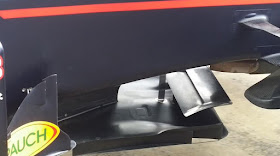Red Bull appeared at the first pre-season Formula 1 test this week with an interesting wing perched atop the T-tray splitter beneath the chassis. As Craig Scarborough points out on Autosport.com, the tips of this wing act as vortex generators. Craig also points out that the idea has been tried before, on the Brawn 001 in 2009.
The interesting thing about such a device is that it's profiled in the manner of an aircraft wing, generating low-pressure above and high pressure below. The consequence of this is that it generates vortices rotating in the same sense as the Y250 vortex on each side of the chassis.
So, for example, looking from a perspective in front of the car, and focusing on the right-hand-side of the chassis, both the Y250 vortex and the T-tray wing vortex rotate in an anticlockwise direction. On the left-hand-side, they both rotate in a clockwise direction.
Now, this is in contrast with the influence provided by a J-vane vortex. As alluded to in Jonathan Pegrum's 2006 academic work, when a vortex spinning around an axis pointing in the direction of the freestream flow
passes close to a solid surface, it tends to pull a counter-rotating
vortex off the boundary layer of that surface. Hence, when the Y250 vortex passes the J-vanes hanging from the underside of the raised nose on a Formula 1 car, it creates a pair of counter-rotating vortices on each side of the chassis.
For vortices sharing approximately the same rotation axis, it is a general rule that counter-rotating vortices tend to repel each other, whereas co-rotating vortices tend to attract each other. In fact, for a time, co-rotating vortices will orbit a common center of vorticity. This situation will persist so long as they are separated by a distance large compared to their vortex-core radii. Eventually, however, viscous diffusion will enlarge their respective cores, and they will begin to deform each other, eject arms of vorticity, and finally merge into a single, larger vortex.
Because the J-vane vortex rotates in the opposite sense to the Y250, it tends to repel it. Hence, the J-vane can be used to push the Y250 into the optimal position to fulfil its ultimate purpose, which is to push the front-wheel wake further outboard.
However, the J-vane vortex can only push the Y250. Fitting a T-tray wing, which presumably generates vortices with the same sense of rotation as the Y250 itself, conceivably provides Red Bull with the ability to push and pull the position of the Y250, from two different downstream locations. That possibly improves their ability to fine-tune the position of the Y250 in both a vertical and lateral direction. Alternatively, of course, it may just be designed to interact with the vorticity generated by the bargeboards et al.
Whilst Brawn tried the same concept in 2009, note that the Brawn wasn't fitted with J-vanes, and the presence of a double-diffuser might have reduced the sensitivity of the diffuser to ingress of the front-wheel wake anyway.

No comments:
Post a Comment
Note: only a member of this blog may post a comment.